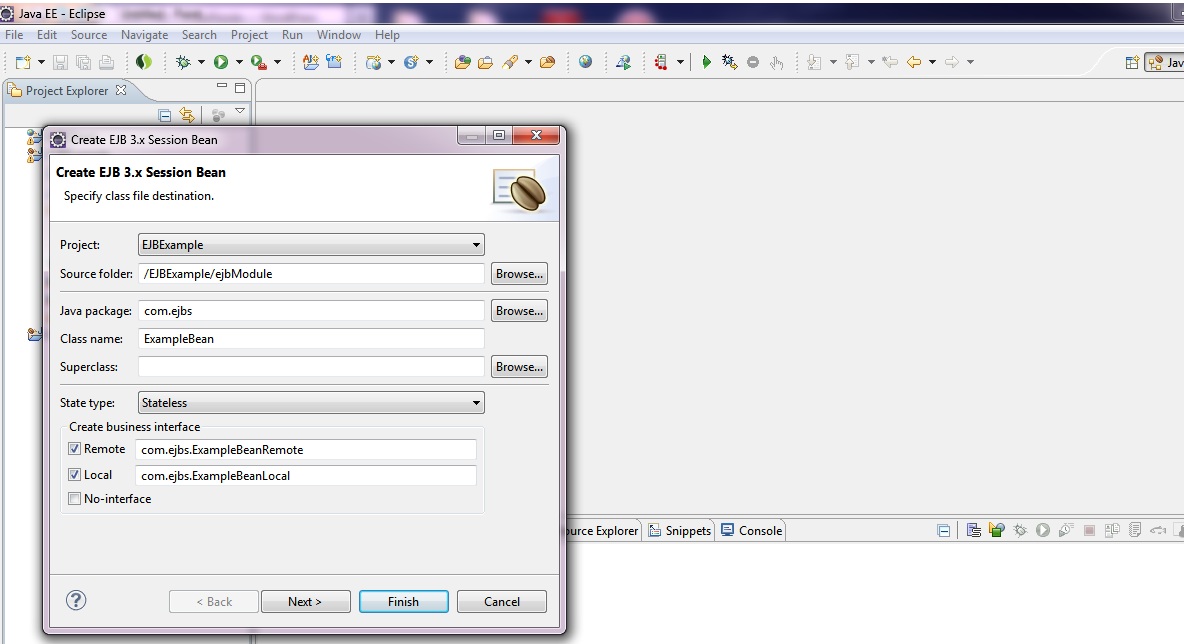In the previous chapter we discussed the fundamental concepts of EJB. In this chapter we are discussing an EJB Stateless Session Bean example.
Stateless Session Bean – An overview
Stateless session Bean is a type of session bean , which does not keep a conversational state with calling client.In simple words , if the bean has two business methods in it , the state of the bean when executing first business method will not be retained for the second method. This ensures maximum re usability of a bean component . Because Stateless Session Bean does not keep client specific states.
Stateless Session Bean Life Cycle
A stateless session bean has only two states throughout its entire life cycle.
1)Does not exist state
2)Ready for invocation from client.
The EJB container creates a pool of beans and does the necessary dependency injection. Then , if a method with @PostConstruct annotation is there ,it will be invoked.Now the bean is ready for client invocation.If a method annotated with @PreDestroy is there , then that method will be invoked at the end of client invocation. Now the bean is ready for garbage collection.
EJB Stateless Session Bean Example
Now let us discuss an example. In this case our bean has only one business method. The method returns a String message. The invoking client application accesses the EJB and displays the message in its console.The example uses EJB 3.0 specifications.
The tools and software needed for our application are:
1)Java EE SDK 1.6 – Download link
2)Eclipse Indigo – Download link
3)JBoss-6.0.0.M1 – Download link
If JDK is not installed , install it. Extract and put eclipse and JBoss to suitable locations.
Step by Step description
1) Open eclipse with suitable workspace.
2)Select File –>New–>EJB Project . The following window will be shown. Give a suitable name for the project. In this case I am giving the name as EJBExample. Select JBoss 6.x as target run time and 3.0 as EJB version.
3)Press Next button for all coming windows. When the Finish button comes , click it.
4)Now select the Servers tab near eclipse console.
5)Right click and select New–>Server.
 Select JBoss 6.x as run time and click on Next.
Select JBoss 6.x as run time and click on Next.
6)Locate the server installation and click Next.Add our EJBExample to the server . And then press Finish.
7)Now right click on the ejbModule and New –>Package.
Give a suitable name to the package and then press Finish.(This example is using com.ejbs as package name)
8)Now right click on the newly created package and select New–>Session Bean.Give class name as ExampleBean and select both remote and local options .Select state type as stateless.
Press Next and then Finish.
9)Now add the method public String getMessage() to the remote and local interfaces.
ExampleBeanLocal.java
import javax.ejb.Local;
@Local
public interface ExampleBeanLocal {
public String getMessage();
}
ExampleBeanRemote.java
import javax.ejb.Remote;
@Remote
public interface ExampleBeanRemote {
public String getMessage();
}
10)Paste the methods in ExampleBean.java. It has the business method implemented from remote and local interfaces.
ExampleBean.java
import javax.ejb.Stateless;
/**
* Session Bean implementation class ExampleBean
*/
@Stateless
public class ExampleBean implements ExampleBeanRemote, ExampleBeanLocal {
public ExampleBean() {
}
@Override
public String getMessage() {
return "This is a message from Stateless Session Bean";
}
}
11)Now start the server (If the project EJBExample is not added to early , we need to add it to the run time).
Once the deployment of EJB is done , the EJB instance will be bound to name space by the container itself.(JNDI concepts were discussed earlier)The details of beans with JNDI bindings will be displayed in the console.
INFO [JndiSessionRegistrarBase] Binding the following Entries in Global JNDI:
ExampleBean/remote – EJB3.x Default Remote Business Interface
ExampleBean/remote-com.ejbs.ExampleBeanRemote – EJB3.x Remote Business Interface
ExampleBean/local – EJB3.x Default Local Business Interface
ExampleBean/local-com.ejbs.ExampleBeanLocal – EJB3.x Local Business Interface
12)Now let us create our client application. For that create a Dynamic Web Project with JBoss6.x as target run time.Add the EJBExample project as dependency. And create a class in it .
ExampleBeanClient.java
import java.util.Properties;
import javax.naming.InitialContext;
import javax.naming.NamingException;
import com.ejbs.ExampleBeanRemote;
public class ExampleBeanClient {
public static void main(String[] args) {
try {
Properties props = new Properties();
props.setProperty("java.naming.factory.initial",
"org.jnp.interfaces.NamingContextFactory");
props.setProperty("java.naming.factory.url.pkgs",
"org.jboss.naming");
props.setProperty("java.naming.provider.url", "127.0.0.1:1099");
InitialContext ctx = new InitialContext(props);
ExampleBeanRemote exampleBean = (ExampleBeanRemote) ctx
.lookup("ExampleBean/remote");
System.out.println("Message from Bean :" + exampleBean.getMessage());
} catch (NamingException e) {
e.printStackTrace();
}
}
}
The properties object gives the initial properties to retrieve the already bound bean instance.
12)Now run the client application as a Java Application.
Output
Message from Bean :This is a message from Stateless Session Bean
So we created a stateless session bean and deployed in server.We accessed the bean using remote interface. We can access the EJB using local interface , if we select client and server in the same host.
Understanding Stateless Session Bean Life Cycle
In the above ExampleBean.java , we implemented only the getMessage() method of remote and home interfaces. If we replace the existing ExampleBean.java with the new one , which has the methods with @PostConstruct and @PreDestroy annotations, then we can understand the life cycle by analyzing the server log file (Path : %JBOSS_HOME%/server/default/log ,if we are sing the default configuration as running configuration).
ExampleBean.java
import javax.annotation.PostConstruct;
import javax.annotation.PreDestroy;
import javax.ejb.Stateless;
import org.slf4j.Logger;
import org.slf4j.LoggerFactory;
/**
* Session Bean implementation class ExampleBean
*/
@Stateless
public class ExampleBean implements ExampleBeanRemote, ExampleBeanLocal {
private static Logger LOGGER = LoggerFactory.getLogger(ExampleBean.class);
public ExampleBean() {
}
@Override
public String getMessage() {
LOGGER.info("Method getMessage() is invoked by a client");
return "This is a message from Stateless Session Bean";
}
@PostConstruct
public void doAfterStartup() {
LOGGER.info("Bean instance has initilized");
}
@PreDestroy
public void doBeforeCleanup() {
LOGGER.info("Bean will be garbage collected soon..");
}
}
See Related Topics
JNDI
JMS
EJB
EJB Stateful Session Bean Example


